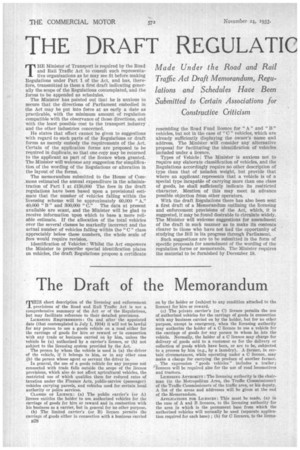The Draft of the Memorandum
Page 38

If you've noticed an error in this article please click here to report it so we can fix it.
HIS short description of the licensing and enforcement 1_ provisions of the Road and Rail Traffic Act is not a comprehensive summary of the Act or of the Regulations, but may facilitate reference to their detailed provisions,
lacsasive RizotrrammENTs: On and after the appointed date (that contemplated is July 1, 1934) it will not be lawful for any person to use a goods vehicle on a _road either for the carriage of goods for hire or reward or in connection with any trade or business carried on by him, unless the vehicle be (a). authorized by a carrier's licence, or (b) not subject to the licensing system provided by the Ad.
The person by whom the vehicle is used is (a) the driver of the vehicle, if it belongs to him, or in any other case ,(13) the person whose agent or servant the driver is.
In general, the use of a goods vehicle for any purpose not connected with trade falls outside the scope of the licence provisions, which also do not affect agricultural vehicles, the restricted use of which qualifies them for reduced rates of taxation under the Finance Acts, public-service (passenger) vehicles carrying parcels, and vehicles used for certain local authority or police services.
CLASSES OE LICENCE: (a) The public carrier's (or A) licence entitles the holder to use authorized vehicles for the carriage of goods for hire or reward and in connection with his business as a carrier, but in general for no other purpose.
(h) The limited carrier's (or B) licence permits the carriage of goods either in connection with a business carried B28
on by the holder or (subject to any condition attached to the licence) for hire or reward. (c) The private carrier's (or C) licence permits the use of authorized vehicles for the carriage of goods in connection with any business carried on by the holder, but for no other purpose, except in emergency, when the licensing authority may authorize the holder of a C licence to use a vehicle for the carriage of goods for any person to whom he lets the vehicle. Normally, the holder of a C licence may charge for delivery of goods sold to a customer or for the delivery or collection of goods which have been, or are to be, subjected to a process by him (e4,, by a laundry). A farmer, in certain circumstances, while operating under a C licence, may make a charge for carrying the produce of another farmer. ,., The expression "goods vehicles" includes a trailer ; "licences will be required also for the use of road locomotives and tractors.
LICENSING AUTHORITY: The licensing authority is the chairman (in the Metropolitan Area, the Traffic Commissioner) of the Traffic Commissioners of the traffic area, or his deputy. A list of the areas and addresses will, be given at the end of the MeRIOISEdUtil.
APPLICATIONS TOR LICENCES: This must be made, (a) in the case of A and B licences, to the licensing authority for the area in which is the permanent base from which the authorized vehicles will normally be used (separate application required for each base) ; (b) for C licences, to the licens




















































































